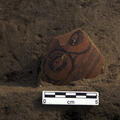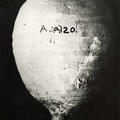Female figurine with a double volute headdress from Harappa
The "cones" that often decorate figurine headdresses may be reproductions of the small gold cones that have been found at Indus Civilization sites. Similar small gold cones are still used as hair ornaments in South Asia.
Approximate dimensions (W x










